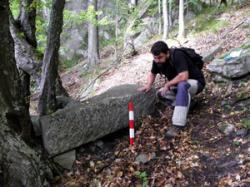- 24 AOÛT
- INDI-UNI : 
PRE-INSCRIPTION : 15 Juin – 31 Août
PRE-REGISTRATION: June 15th - August 31st
- BULGARIE –  Kozi Gramadi - The team of archeologists led by Ivan Hristov from the National Museum of History ran into the ruins of an early Christian church lying at some 2km to the north of the largest Thracian sanctuary ? ? that of Chetinyova Mogila, near the village of Starosel. The church was obviously a part of a larger complex which suggests a monastery was functioning there. The newly found church is the sixth one unearthed in the vicinity of the villages of Krasnovo and Matenitsa. The Christian monuments situated on the southern slopes of Sredna Gora Mountains that was sacred to the Thracians in the past were built on the spots hiding pre-Christian mound and rock sanctuaries. Archeologist Ivan Hsritov believes that when in the 4th century the Thracians converted to Christianity they kept the memory of their sacred sites and revived the region to new spiritual life.
Kozi Gramadi - The team of archeologists led by Ivan Hristov from the National Museum of History ran into the ruins of an early Christian church lying at some 2km to the north of the largest Thracian sanctuary ? ? that of Chetinyova Mogila, near the village of Starosel. The church was obviously a part of a larger complex which suggests a monastery was functioning there. The newly found church is the sixth one unearthed in the vicinity of the villages of Krasnovo and Matenitsa. The Christian monuments situated on the southern slopes of Sredna Gora Mountains that was sacred to the Thracians in the past were built on the spots hiding pre-Christian mound and rock sanctuaries. Archeologist Ivan Hsritov believes that when in the 4th century the Thracians converted to Christianity they kept the memory of their sacred sites and revived the region to new spiritual life.
http://paper.standartnews.com/en/article.php?d=2011-08-21&article=37058
- AUSTRALIE –  Tasmanie - A series of archaeological finds in Tasmania have shown how colonial guards secretly eased the brutal treatment of women prisoners in 1850s Australia, rewriting our understanding of life inside Britain’s colonial prisons Down Under. University of Manchester archaeologist Dr Eleanor Casella says the find of textile manufacturing paraphernalia in a Tasmanian prison nursery proves women prisoners were allowed informal contact with their babies - a contravention of official British policy for the management of imperial convicts. . Dr Casella had spotted three intact lead bale seals while excavating the nursery of the Ross Female Factory, a heritage-listed prison which confined British criminal women and their children exiled to Van Diemen’s Land - now Tasmania. They were put to use making convict uniforms out of cotton and woollens imported from the textile factories of north-west England. The lead seals – which prevent theft from the bolts of cloth during export down to the penal colonies –were found alongside fragments of buttons, sewing pins and thimbles. Dr Casella has been excavating at the Ross Factory site for over 15 years. She said: “Strict official regulations kept criminal mothers separated from their children. It was a dark period for many thousands of people. “But the bale seals and other textile-related fragments we found suggest the Ross Factory Superintendent ignored formal orders and allowed women to complete their required work assignments in the company of their children.“That was a very direct and never documented subversion of the formal British penal regulations that governed this penal colony.
Tasmanie - A series of archaeological finds in Tasmania have shown how colonial guards secretly eased the brutal treatment of women prisoners in 1850s Australia, rewriting our understanding of life inside Britain’s colonial prisons Down Under. University of Manchester archaeologist Dr Eleanor Casella says the find of textile manufacturing paraphernalia in a Tasmanian prison nursery proves women prisoners were allowed informal contact with their babies - a contravention of official British policy for the management of imperial convicts. . Dr Casella had spotted three intact lead bale seals while excavating the nursery of the Ross Female Factory, a heritage-listed prison which confined British criminal women and their children exiled to Van Diemen’s Land - now Tasmania. They were put to use making convict uniforms out of cotton and woollens imported from the textile factories of north-west England. The lead seals – which prevent theft from the bolts of cloth during export down to the penal colonies –were found alongside fragments of buttons, sewing pins and thimbles. Dr Casella has been excavating at the Ross Factory site for over 15 years. She said: “Strict official regulations kept criminal mothers separated from their children. It was a dark period for many thousands of people. “But the bale seals and other textile-related fragments we found suggest the Ross Factory Superintendent ignored formal orders and allowed women to complete their required work assignments in the company of their children.“That was a very direct and never documented subversion of the formal British penal regulations that governed this penal colony.
http://www.manchester.ac.uk/aboutus/news/display/?id=7318
- ROYAUME UNI –  Conwy - Three medieval walls, thought to be nearly 700 years old, have been found in the grounds of a Conwy hotel. Drainage work at the Maenan Abbey Hotel, near Llanrwst, unearthed two walls - one thought to be the original abbey's cloister wall - underground. On Monday, a third wall was discovered . It's believed to be the cloister wall of the abbey, built in 1282. They're about 6ft thick. The abbey is believed to have been built in about 1282, to relocate monks after King Edward I ordered the removal of their Cistercian monastery from Conwy town, so he could build a castle there.The abbey was destroyed in the 16th Century during Henry VIII's dissolution of the monasteries, and the current property was built in the 19th Century.
Conwy - Three medieval walls, thought to be nearly 700 years old, have been found in the grounds of a Conwy hotel. Drainage work at the Maenan Abbey Hotel, near Llanrwst, unearthed two walls - one thought to be the original abbey's cloister wall - underground. On Monday, a third wall was discovered . It's believed to be the cloister wall of the abbey, built in 1282. They're about 6ft thick. The abbey is believed to have been built in about 1282, to relocate monks after King Edward I ordered the removal of their Cistercian monastery from Conwy town, so he could build a castle there.The abbey was destroyed in the 16th Century during Henry VIII's dissolution of the monasteries, and the current property was built in the 19th Century.
http://www.bbc.co.uk/news/uk-wales-north-west-wales-14545255
- IRLANDE - Kinsale Head - A diving expedition on the wreck of the Lusitania has recovered some key pieces of equipment, which were handed over to the receiver of wrecks last night. A bronze telemotor, which was part of the ship’s steering mechanism, was among the items recovered from the vessel, which sank 11 miles off Kinsale Head, Co Cork, in 1915 after it was torpedoed by a German submarine. Some 1,198 people died, including gallery director Sir Hugh Lane, and 764 passengers survived the sinking, which is said to have been instrumental in pulling the US into the first World War. Claims the ship was carrying munitions and that British intelligence was involved in a cover-up have contributed to the controversy surrounding the loss.
http://www.irishtimes.com/newspaper/ireland/2011/0823/1224302863236.html
- CHINE – Araxan - More than 200 coins that were used 1,000 years ago were excavated in north China's Inner Mongolia Autonomous Region. The green verdigris-covered coins, most from the Northern Song Dynasty (960-1127) and some from the Tang Dynasty (618-907), were unearthed at a construction site in Araxan League , said Zhang Zhenzhou with the Araxan Museum. Zhang added that the place where the coins were found belonged to the Western Xia Kingdom, which means that the area was probably a business hub between Northern Song and Western Xia. Zhang's opinion is echoed by Li Daxiang, curator of Weiwu municipal museum in Gansu Province. "Despite the many battles between the two kingdoms, bilateral trade was booming, which lead to the transfer of the Northern Song coins to Western Xia," Li said. Probably people tried to hide their money during warfare by burying the coins, Zhang said. The archaeologists are classifying and studying the coins in order to ascertain in which year the coins were buried and hopefully shed some light on ancient bilateral trade, Zhang said. Historical records show that the Song silk, porcelain, iron and various textiles were traded to places as far as the Indus River and modern-day Iraq.
http://news.xinhuanet.com/english2010/china/2011-08/23/c_131068560.htm
- SUISSE – Genève - The Russian submersibles involved in EPFL’s elemo project have discovered a new wreck on the bottom of the lake. Underwater archaeology is benefiting from scanners developed for scientific research. The wreck is most likely an old barge used for hauling stone or gravel. “The boat, about 30 meters long, could date from the end of the 19th or beginning of the 20th century. It must have sunk while navigating, because the anchor and other components were still on board, whereas boats that were sunk deliberately would have been stripped of all useful equipment,” explains Carinne Bertola, from the Musée du Léman in Nyon. Bertola, a specialist in shipwrecks, thinks that it was an old barge that transported materials extracted from quarries in the St. Gingolph area.
http://www.physorg.com/news/2011-08-scanners-reveal-bottom-lake-geneva.html
- MOLDAVIE – Chisinau - The piece of Byzantine liturgical embroidery that goes under the name of 'Stephen the Great's Flag' will be displayed between August 27 and September 10 at the National Museum of Moldova's History and Archaeology in Chisinau, managing director of the National Museum of Romania's History (MNIR) Ernest Oberlander-Tarnoveanu says. Being organized on the most valuable item of Romania's cultural heritage that has so far been presented in the capital city of the Republic of Moldova, the exhibition, which deals with historical subjects, is also the first of this kind opened by Romania in Chisinau in the past 15 years and celebrates the 20th anniversary of the independence of the Republic of Moldova being declared. 'Stephen the Great's Flag' is a 15th century piece of Byzantine embroidery, which is 1.24 metres long and 0.95 metres wide and pictures the iconographic image of Great Martyr George, who is regarded as a symbol of the military victory. Around this piece of embroidery there is an inscription in Old Church Slavonic, namely the prayer of Prince Stephen the Great to the Saint: 'Oh, thou, Great Martyr George, who endured unbearable suffering and came off victorious, who, when one is in need and distress, make haste to defend and give war-hearted help to the poor, take from us, with great joy, this prayer, which is said by your humble servant, the Prince, me, Stephen, who am ruler of Moldavia with God's blessing, protect him from evil this century and the one to come with the prayers that honour you for us to praise you for ever and anon, amen. It was said in the year 7008 (1500) and 43 of his reign.'
http://bsanna-news.ukrinform.ua/newsitem.php?id=16900&lang=en